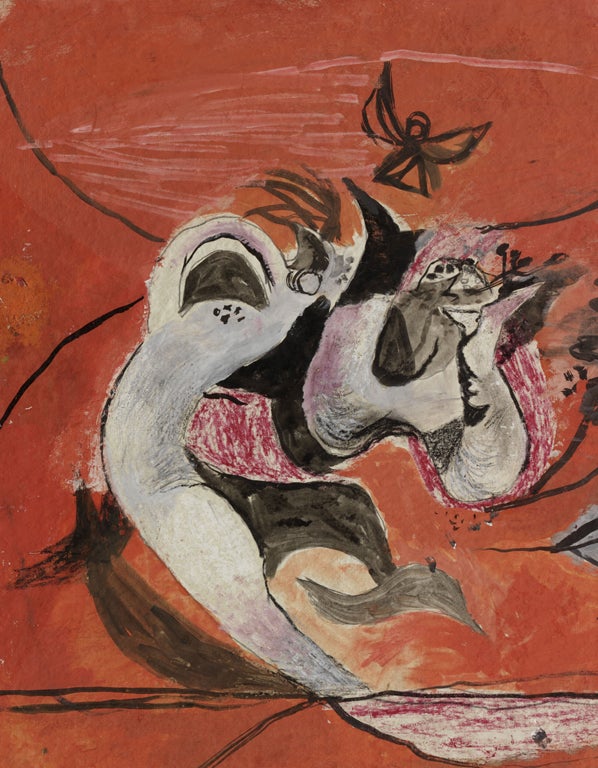Graham Sutherland: An Unfinished World, Modern Art, Oxford The Mystery of Appearance: Conversations Between Ten British Post-war Painters, Haunch of Venison, London
Sutherland is one of many mid-20th-century artists storming back into fashion at galleries and in salerooms alike

For as long as I can remember, Modern British art – roughly, the kind made between 1920 and 1960 – has been out of fashion, consigned to distant galleries run by people in tweeds. Now it is back, and in spades.
As I write, Victor Pasmore is on at the New Art Centre in Wiltshire, while a Ben Nicholson show opens at the Courtauld next month. So, too, does Picasso and Modern British Art at Tate Britain, aimed, like the Courtauld's show, at splicing its subject to a Continental mainstream. There is a Burra exhibition in Chichester, a Piper in Eastbourne. Most unexpected, though, is a show of Graham Sutherland's work in Oxford, in part because posterity has hit Sutherland hardest of all, partly because the show is at the city's museum of modern art, but mostly because it is curated by George Shaw, a contestant in last year's Turner Prize.
What's it all about? Maybe the rediscovery of Modern British art echoes the reappearance on London menus of toad-in-the-hole: when times are dark, we crave home cooking. In any case, there's been some revisionism going on. Alexandra Harris's recent book Romantic Moderns argued that painters such as John Piper, long dismissed as parochial and reactionary, were neither, that "English modernism" was not a contradiction in terms, and that our artists were not anti-modern but differently so. Modern Art Oxford's Graham Sutherland: An Unfinished World, starts from the same premise.
In his catalogue to the show, George Shaw describes Sutherland as an "insistent worm" burrowing into his own work. Those who know Shaw's pictures – images of lock-up garages in tinny Humbrol paint – may find this surprising. Shaw's childhood exposure to Sutherland's Coventry Cathedral tapestry apart, it is hard to see any link between the two artists, or why one is curating the other. There is a niggling suspicion that MAO felt a straight Sutherland exhibition would flop, and that Shaw was brought in to make the old man relevant. It is not a flattering assumption.
For all that, this is a lovely show. The work – on paper and much of it from private collections – is divided between studies Sutherland made in Wales in the 1930s and others done as a war artist, with a handful of post-war images at the end. The first set of pictures show how the artist struggles with the question raised by Paul Nash in 1932: "Whether it is possible to 'go modern' and still 'be British'."
Landscape painting is a British tradition, grafting European modernism onto it a British problem. For Sutherland, the tilled and husbanded soil of Wales becomes a metaphor for his own work-in-progress, a Sisyphean task that can never be completed. While Nash and Ivon Hitchens tied their landscapes to a history of lyrical conservatism, Sutherland sees the land as Blake and Palmer did, as something lovely but monstrous. Thus the suite of thorn trees in their own room in this show, or the grotesque Twisted Tree Form (1944), like the scabrous remains of a burns victim.
What one senses, maybe, is the rack on which Sutherland found himself. His lightning-struck trees have a strongly Surrealist – which is to say, foreign – feel; and yet they are Welsh. Something about the battle between those two things, European modernity and British tradition, makes these pictures both unresolved and unsatisfactory and extraordinarily powerful. Once the Anglo-European war becomes real rather than figurative, Sutherland loses his power. The studies of bombed buildings in his Devastation series are dramatic, but their horror lies in the subject rather than Sutherland's struggle to depict it. The handful of late works in the show, dating from the 1950s and '60s, shows what can happen when an artist becomes happy with what he is doing. They are not a good advertisement for contentment.
As you might expect, the new vogue for Modern British has also been reflected in salerooms and private galleries. One of the more ambitious results is at Haunch of Venison and is called, mysteriously, The Mystery of Appearance. Like MAO's Sutherland show, its aims are revisionist – in this case, to take 10 postwar British artists and consider them en masse rather than in the pigeon-holes in which art history has placed them. Thus Francis Bacon (School of London) rubs shoulders with William Coldstream (Euston Road), Michael Andrews (Norwich Twenty), Richard Hamilton (Pop) and Patrick Caulfield (kind of Photorealism). If we're meant to take away the sense of a particular English-ness in art, I'm not sure the show succeeds. But the idea that a modern gallery would even want to suggest such a thing makes it interesting, as are many of the works.
Graham Sutherland (01865 722733), to 18 Mar; 'The Mystery of Appearance' (020-7495 5050) to 18 Feb
Next Week:
Charles Darwent sees Alberto Burri at the Estorick Collection
Art choice
Lots of shows close this month, so it's a case of catch 'em while you can ... don't miss John Martin's Apocalypse at Tate Britain, for a dose of end-of-the-world fire and brimstone, or the V&A's Postmodernism: Style and Subversion, an eclectic, shiny-surfaced collection of art, architecture, fashion and pop culture: both end on Saturday.
Join our commenting forum
Join thought-provoking conversations, follow other Independent readers and see their replies
Comments